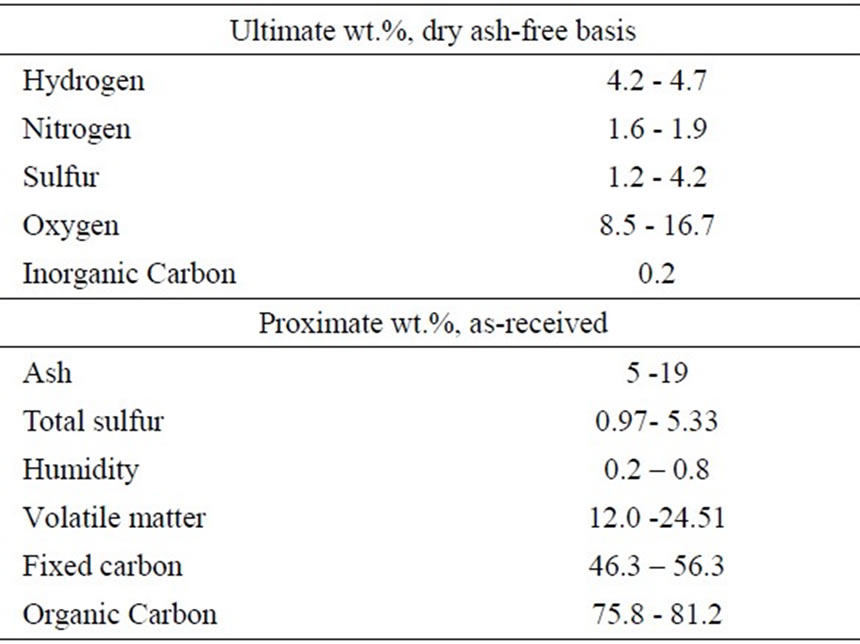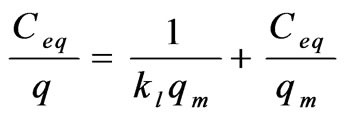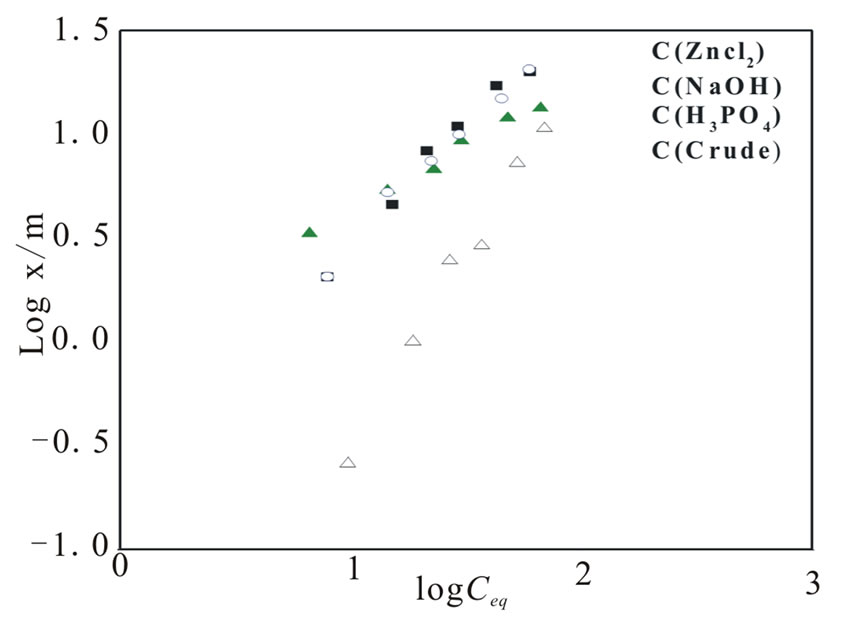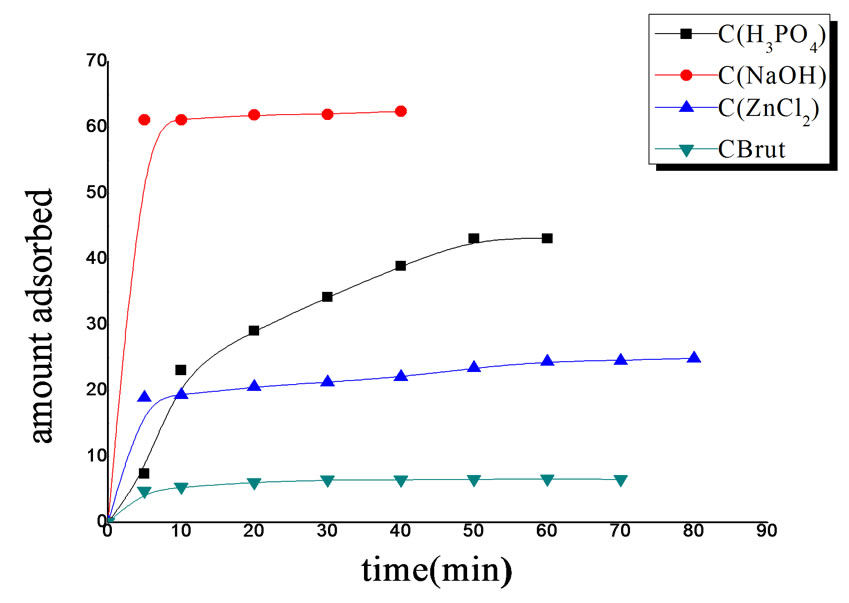Journal of Water Resource and Protection
Vol. 2 No. 9 (2010) , Article ID: 2711 , 5 pages DOI:10.4236/jwarp.2010.29091
Phenol Adsorption from Crude and Active Coals
1Laboratory of materials and catalysis, Faculty of Sciences, Djilali Liabes University,
Sidi Bel-Abbès, Algeria.
2Laboratory of Environmental Chemistry Faculty of Science, University Ibn Khaldoun,
Tiaret, Algeria.
3Faculty of Sciences, University of Bechar, Bechar, Algeria.
E-mail: abbes.hissi@yahoo.fr
Received June 11, 2010; revised June 21, 2010; accepted July 3, 2010
Keywords: Activated Coal, Crude Coal, Chemical Activation, Adsorption
ABSTRACT
The aim of the present work is the removal of phenol by adsorption on a raw and activated crude or hard coal (C) with NaOH, ZnCl2 and H3PO4 in the region of Bechar (south-western Algeria). The development of adsorbents from precursors is inexpensive, requiring innovative techniques using concepts developed relevant to the physical handling, processing physical and chemical activation of coal into an activated coal, with the ability of fixing aromatic organic pollutants, namely phenol. The maximum surface area obtained from the activation with ZnCl2, H3PO4 and NaOH were 1000, 850 and 3000 m2 / g, respectively. The results clearly showed that hard coal activation greatly improved phenol fixing. The rate of phenol adsorption by activated hard coal is much higher than those obtained from raw coal through its holding capacity. Activated carbon porosity with NaOH is much higher than those obtained from coal activated by ZnCl2 and H3PO4. Activated coal can be an effective means of confinement in industrial disposal sites, avoiding migration of organic pollutants contained in these wastes to groundwater via the adsorption phenomenon. The development of such effective barriers, based on local resources can help solve the problem of water contamination.
1. Introduction
Phenol is a highly toxic and carcinogenic compound and its adsorption is very important to meet the environmental regulations.
The content of phenolic compounds in industrial waste water (about 200-2000 mg/L) is generally higher than the standard norms (mostly less than 0.5 mg/L) prepared for their release into the environment water [1].
Active Coal adsorption is one of the most effective technologies for removing organic substances and toxic dyes. Nevertheless, basic study of adsorption kinetics must be considered in advance. For an efficient adsorption process, the kinetic study allows the rapid removal of pollutants from the solution while the adsorption equilibrium is the ultimate capacity of adsorption [2].
In principle, the process for the preparation of activated carbons can be divided into two tests using physical and chemical methods. The physical method consists in the carbonization of precursors followed by gasification of coal resulting in steam or carbon dioxide [3-5].
The formation of a porous structure is obtained by the removal of a large amount of internal carbon mass.
The coal at high porosity can be obtained only at high levels of burned coal. The chemical method was carried out by carbonization of the raw material impregnated with a chemical reagent (eg, ZnCl2, H3PO4 and NaOH). Due to the properties of dehydrogenation, reagents favor the formation of chemical crosslink, leading to the formation of a rigid matrix, less prone to volatile loss and volume contraction during carbonization [6-8].
Adsorption is one of the most effective methods of advanced wastewater treatment that industries employ to reduce the hazardous waste organic and inorganic effluents. It is also used to remove toxic organic compounds and inorganic-contaminated groundwater [9-10].
In this work a sample coal was chosen as a precursor of activated carbons, in addition to various activating agents, including ZnCl2, H3PO4 and NaOH were used in the preparation. Changes in behavior during the carbonization of the samples treated with these reagents were rarely studied and have, to our knowledge, never been compared in the literature. In the above framework, this paper describes the influence of different chemical reagents on weight loss behaviors during carbonization, and the development of surface characteristics of carbons prepared with carbonization temperature.
2. Materials and Methods
An Algerian Coal from the region of Bechar was used as the starting material. The characteristics of the adsorbent used are shown in Table 1. Unless otherwise specified, the particle sizes of the coal used for carbon preparation were within a range of 0.2 mm.
2.1. Pyrolysis
About 45 g of Coal (0.2 mm) was heated to 1000˚C in an atmosphere of the gases evolved during the pyrolysis process. Then, a quartz tube (i.d. 30 mm) carrying the sample was inserted into a horizontal tabular furnace between 40 and 450 mm long. After that, the quartz tube was connected to a tar condenser. At the beginning of each experiment, air was removed from the system by purging with N2. The heating rate was 5˚C min and the soaking time 30 min. The yields of Coke, tar and gas were determined, but the gases from pyrolysis were not analyzed.
2.2. Chemical Activation
As stated in the preceding section, chemical activation of the Coal was performed using ZnCl2, H3PO4 and NaOH as reagents. The activation process was initiated in a 250 ml glass-stoppered flask by mixing 1 g of the as-received coal with a solution consisting of 50 g of water and 4.25 g of a chemical reagent. Then the flask was immersed in

Table 1. Characteristics of coals.
a constant-temperature shaker bath, with a shaker velocity of 100 rpm. The mixing was performed at 85˚C and lasted for 3 h. After mixing, the Coal slurry was subjected to vacuum drying at 110˚C for 24 h. The resulting chemical loaded samples were then carbonized in a horizontal cylindrical furnace (60 mm i.d) in N2 atmosphere, with a flow rate of 100 ml/min. Carbonization was carried out by heating the samples at 30˚C/min from room temperature to carbonization temperatures in a range of 400-900˚C, followed by holding the samples at the carbonization temperature for 1 h before cooling under N2.
After cooling, the carbonized products that were treated with ZnCl2 or NaOH were then subjected to washing by stirring with 250 ml of 0.5 N HCl solutions at 85˚C for 30 min, followed by filtration of the mixture. The acid-washed samples were then leached by mixing with 250 ml of distilled water at 85˚C for several times until the pH value of the water-carbon mixture was above 6. The leached products were then dried by vacuum at 110˚C for 24 h to obtain the activated carbon products. As for the samples treated with H3PO4, an NaOH solution was used instead of the HCl solution in the washing process and the samples were leached by distilled water to reach a pH value less than 8.
In order to better understand the carbonization process, a thermo gravimetric analyzer (TGA, Perkin-Elmer TGA 7) was employed to monitor the volatile evolution behavior by heating the chemical-loaded samples from room temperature to 900˚C at 30˚C/min. A sample of 30-50 mg was used for each TGA analysis.
Specific surface areas and pore volumes of the carbon products were determined by gas adsorption. An automated adsorption apparatus (Micromeritics, ASAP) was employed for these measurements.
Next, adsorption of N2, as probe species, was performed at 196˚C. Nitrogen surface areas and micropore volumes of the samples were determined from the BET and Dubinin–Radushkevich (D-R) Equations, respectively. The amount of N2 adsorbed at pressures corresponds to the total amount adsorbed at both microspores and mesopores; thereby subtracting of the micropore volume from the (D-R) Equation. The total amount of N2 (determined at P/P0 = 0.98 in this case) will provide the volume of the mesopore [11].
2.3. Kinetic studies
Experiments were conducted by contacting known amounts of different adsorbents with 200 ml of synthetic wastewater containing 70 mg/l of aqueous phenol solution.
The solution containing the adsorbents was left for 72 h. After the equilibrium time, the treated solution was centrifuged and the supernatant solution was analyzed for intial concentration of phenol at λmax = 270 nm using UV spectrophotometry.
2.4. Modeling the adsorption isotherm
Modeling of the equilibrium data was done using Freundlich and Langmuir isotherms [12].
Langmuir Equation: The Langmuir Equation is the most widely used two-parameter equation, commonly expressed
 (1)
(1)
 (2)
(2)
where:
Ceq = equilibrium concentration of adsorbate in solution after adsorption; x/m = amount adsorbed per adsorbent unit weight; and kl and qm are the Langmuir constants.
From a plot of Ceq/(x/m) versus Ceq, kl (mg/g) and qm (L/mg) can be determined from the slope and intercept, respectively. At equilibrium conditions, the adsorbed amount x/m can also be predicted using the Freundlich Equation
 (3)
(3)
where the parameters k and n can be obtained using the linear form
 (4)
(4)
where kf is an indication of the adsorbent capacity and 1/n is a measure of the surface heterogeneity, ranging between 0 and 1, becoming more heterogeneous as its value gets closer to zero. Using Equation (3) from the plot of log x/m versus log Ceq, the parameters n and k were obtained from the slope and intercept, respectively.
Since the analysis of the isotherm is important in order to develop an Equation that accurately represents the results and which could be used for design purposes, two have been applied in this study, the Langmuir (1), Freundlich (2) out of the several isotherm Equations.
Adsorption model constants, the values which express the surface properties and affinity of the adsorbent, can be used for our Coal sample. The parameters in the models were estimated by nonlinear regression and by fitting transformed data to the linearized forms of the models.
3. Results and Discussion
Coal activated by H3PO4, ZnCL2, and NaOH was used for the removal of phenol.
Using Equation (2), from the plot of log(x/m) versus log Ceq (Figure 1), the parameters n and k were obtained from the slope intercept, respectively.
Figure 2 shows the plot of 1/(x/m) versus 1/Ceq for phenol using Coal (C (H3PO4), C (ZnCL2), C (NaOH)) as adsorbent, and Langmuir constants were determined from the slope and intercept.
From the Equation  we had
we had

The fixing of the phenol on Coal activated by NaOH

Figure 1. Freundlich adsorption isotherm for phenol (Coals activated by NaOH, ZnCl2, H3PO4).

Figure 2. Langmuir adsorption isotherm for phenol (Coal activated by NaOH, ZnCl2, H3PO4 and raw coal).
complies with the Freundlich model with a regression coefficient of R2 = 0.98.
The constant characteristic KF = 1.01; n = 1.59 and the isotherm follow the Equation x/m = 1.01(Ceq) 0.62
The phenol fixing isotherm on Coal activated by ZnCl2 obeys the Freundlich model with a regression coefficient of R2 = 0.98
The constant KF = 0.23; n = 0.91
= > x/m = 0.23 (Ceq) 1.09
The fixing of the phenol on coal activated by H3PO4, obeys the Freundlich model with a regression coefficient of R2 = 0.98
The constant KF = 0.20; n = 0.85
= > x/m = 0.20 (Ceq) 1.16
The phenol fixing on raw Coal obeys the Freundlich model with the regression coefficient R2 = 0.98
The constant KF = 0.0033; n = 0.53
= > x/m = 0.0033 (Ceq) 1.8
The value of the constant 1/n indicates the adsorption intensity n < 1: weak adsorbent n > 1: good adsorbent n C NaOH good adsorbent n C ZnCl2 good adsorbent n C H3PO4 good adsorbent n C Crude weak adsorbent Capacities of phenol adsorption on these coal samples can be classified as follows:
n C NaOH > n C ZnCl2 > n C H3PO4 > n C Crude Therefore, one can conclude that residual coal treated with NaOH gives the best results among the adsorbents studied.
Figure 3 is a typical plot obtained from investigation in phenol adsorption during equilibrium time of three different carbon types. It is evident that the rapid initial rate of adsorption decreases markedly within time and gave a gradual approach to an equilibrium condition, which was attained after 5 min of contact between phenol solution and activated carbon. It is noticed that after 05-min contact between phenol solution and activated coal with (NaOH; H3PO4; ZnCl2), we obtained 62.4%; 43.08%; 24.87% of phenol retention respectively.
Figure 3 also shows a comparison of the adsorption capacity of the three types of carbon. The Coal activated with NaOH had obviously a larger adsorption capacity than the other two activated carbons.

Figure 3. Effect of contact time on the removal of phenol (Coal activated by H3PO4, ZnCL2, and NaOH.
4. Conclusions
The study of adsorption onto Coal activated carbon in a liquid-solid fluidized bed for phenol, gave rise to the following conclusions:
1. The order of adsorption capacities of adsorbents studied for phenol was in the following array NaOH > H3PO4 > Zncl2
2. The adsorption capacity of Coals increased after treatment with sodium hydroxide, phosphoric acid and zinc chloride.
3. Coal treated with sodium hydroxide was found to give better results among the adsorbents studied.
4. The adsorption isotherm obtained from Coals treated can be represented by a Langmuir and Freundlich Equations for phenol solute.
REFERENCES
- E. G. Furuya, H. T. Chang and K. E. Miura, “Purif,” Technology, Vol. 11, No. 2, 1997, p. 69.
- W. J. Weber and J. C. Morris, “Kinetics of Adsorption in Columns of Fluidized Media,” Journal Water Pollution Control Federation, Vol. 37, No. 4, 1965, p. 425.
- G. Kovacik and B. Wong, “Preparation of Activated Carbon from Western Canadian High Rank Coals,” Fuel Process Technology, Vol. 41, No. 2, 1995, pp. 89-99.
- T. Wigmans and C. P. Bean, “Industrial Aspects of Production and Use of Activated Carbons,” Carbon, Vol. 27, No. 1, 1989, pp. 13-22.
- H. Teng and H. C. Lin, “Activated Carbon Production from Low Ash Subbituminous Coal with CO2 Activation,” AIChE Journal, Vol. 44, No. 5, 1998, pp. 1170-1177.
- F. M. Caturla, S, F. Molina, R. Rodriguez, “Preparation of Activated Carbon by Chemical Activation with Zncl2,” Carbon, Vol. 29, No. 7, 1991, pp. 999-1007.
- M. Jagtoyen, M. J. Thwaites, B. Stencel and F. D. McEnaney, “Adsorbent Carbon Synthesis from Coals by Phosphoric Acid Activation,” Carbon, Vol. 30, No. 7, 1992, pp. 1089-1096.
- M. J. Illán-Gómez, C. Garcıá-Garcıá and C. Salinas-Martınéz, “Activated carbons,” Energy Fuels, Vol. 10, No. 5, 1996, pp. 1108-1114.
- E. Costa, G. Calleja and L. Marijuan, “Adsorpt,” Science & Technology, Vol. 122, No.1, 1987, p. 59.
- M. S. Abdo, S. Nosier and Y. A. Tawil, “Environ,” Science A, Vol. 32, No. 4, 1997, p. 1159.
- F. R. Rodrıguez, M. S. Molina and M. T. Gonzàlez, “The Use of Steam and CO2 as Activating Agents in the Preparation of Activated Carbons,” Carbon, Vol. 33, No. 1, 1995, pp. 15-23.
- R. Juang, F. Wu and R. Tseng, “Adsorption Isotherms of Phenolic Compounds from Aqueous Solutions onto Activated Carbon Fibers,” Journal of Chemical Engineering, Vol. 41, No. 3, 1996, p. 487.

